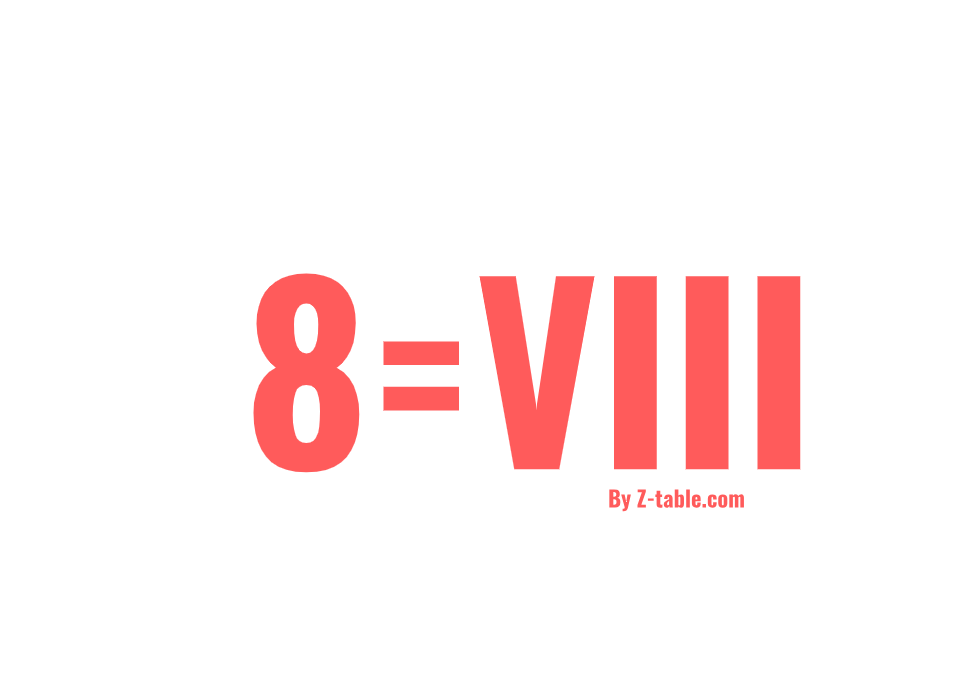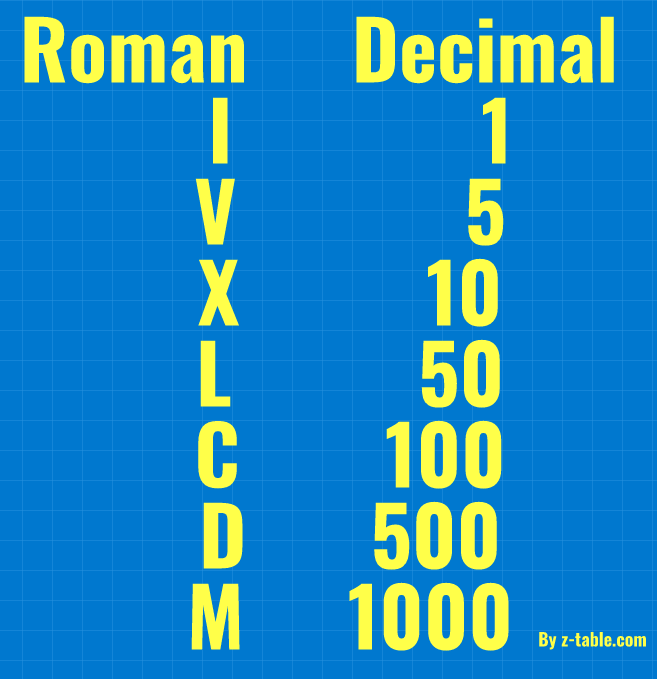What is VIII Roman Numerals?
VIII is a Roman numeral that represents the number 8 in Arabic numerals. It is composed of the Roman numeral symbol V repeated three times. The symbol V represents 5, so three V's combined give us 5 + 5 + 5 = 15. However, in Roman numerals, subtractive notation is used, so instead of representing 15, VIII represents 8. Sometimes conversion of Roman Numerals can be a daunting task, especially for larger numbers. You can always use a Roman numerals converter if you need to quickly convert Roman numerals to decimal numbers .
Composing VIII in Roman Numerals
VIII is composed of three instances of the Roman numeral V. The repetition of V three times represents the value of 5 + 5 + 5 = 15. However, to adhere to the subtractive notation rule, the smaller numeral I (1) is subtracted from X (10) to obtain VIII, which represents 10 - 1 - 1 - 1 = 8.
| Roman Numeral | Value |
|---|---|
| I | 1 |
| V | 5 |
| X | 10 |
| L | 50 |
| C | 100 |
| D | 500 |
| M | 1000 |
Key Principles for Writing Roman Numerals
To write and understand Roman numerals, it is important to keep in mind the key principles:
- A larger letter preceding a smaller letter means their values are added together. For example, VI (6) is written as V + I = 5 + 1.
- A smaller letter preceding a larger letter indicates that the smaller value is subtracted from the larger value. For example, IX (9) is written as X - I = 10 - 1.
- Letters can be repeated up to three times to represent the sum of their values. For example, III (3) represents 1 + 1 + 1.
- A letter should not be repeated more than three times in succession. Instead, subtractive notation is used to represent numbers such as 4 (IV) and 9 (IX).
- A larger letter preceding a smaller letter means their values are added together. For example, VI (6) is written as V + I = 5 + 1.
- A smaller letter preceding a larger letter indicates that the smaller value is subtracted from the larger value. For example, IX (9) is written as X - I = 10 - 1.
- Letters can be repeated up to three times to represent the sum of their values. For example, III (3) represents 1 + 1 + 1.
- A letter should not be repeated more than three times in succession. Instead, subtractive notation is used to represent numbers such as 4 (IV) and 9 (IX).
Numbers Related to VIII in Roman Numerals
Roman numerals consist of the letters I, V, X, L, C, D, and M, which are used to represent different numbers. The Roman numerals related to VIII are as follows:
- I = 1
- II = 2
- III = 3
- IV = 4
- V = 5
- VI = 6
- VII = 7
- VIII = 8
- IX = 9
- X = 10
- I = 1
- II = 2
- III = 3
- IV = 4
- V = 5
- VI = 6
- VII = 7
- VIII = 8
- IX = 9
- X = 10
Fun Facts About VIII Roman Numerals
Here are a couple of fun facts about VIII in Roman numerals:
- In Super Bowl numbering, VIII represents Super Bowl 8, which took place on January 13, 1974, between the Miami Dolphins and the Minnesota Vikings.
- In the ancient Roman calendar, VIII was used to represent the eighth month of the year, October.
Problem Examples for VIII Roman Numerals
Here are a few examples of Roman numeral conversion problems involving VIII:
Example 1: Convert XIV to an Arabic decimal number. To solve this problem, we break down the Roman numeral into its constituent symbols and calculate their values. XIV can be broken down into: X = 10 IV = 4 Adding up the values of each symbol, we get: 10 + 4 = 14. Therefore, XIV in Roman numerals is equivalent to 14 in Arabic decimal numbers.
Example 2: Convert LXXXVIII to an Arabic decimal number. To convert this Roman numeral, we follow the same process as before. LXXXVIII can be broken down into: L = 50 XXX = 30 VIII = 8 Adding up the values, we get: 50 + 30 + 8 = 88. Therefore, LXXXVIII in Roman numerals is equivalent to 88 in Arabic decimal numbers.
Example 3: Convert CDXCIV to an Arabic decimal number. To convert this Roman numeral, we follow the same process as before. CDXCIV can be broken down into: CD = 400 XC = 90 IV = 4 Adding up the values, we get: 400 + 90 + 4 = 494. Therefore, CDXCIV in Roman numerals is equivalent to 494 in Arabic decimal numbers.
Example 1: Convert XIV to an Arabic decimal number. To solve this problem, we break down the Roman numeral into its constituent symbols and calculate their values. XIV can be broken down into: X = 10 IV = 4 Adding up the values of each symbol, we get: 10 + 4 = 14. Therefore, XIV in Roman numerals is equivalent to 14 in Arabic decimal numbers.
Example 2: Convert LXXXVIII to an Arabic decimal number. To convert this Roman numeral, we follow the same process as before. LXXXVIII can be broken down into: L = 50 XXX = 30 VIII = 8 Adding up the values, we get: 50 + 30 + 8 = 88. Therefore, LXXXVIII in Roman numerals is equivalent to 88 in Arabic decimal numbers.
Example 3: Convert CDXCIV to an Arabic decimal number. To convert this Roman numeral, we follow the same process as before. CDXCIV can be broken down into: CD = 400 XC = 90 IV = 4 Adding up the values, we get: 400 + 90 + 4 = 494. Therefore, CDXCIV in Roman numerals is equivalent to 494 in Arabic decimal numbers.
VIII Roman Numerals FAQs
1. How is VIII written in lowercase Roman numerals? In lowercase Roman numerals, VIII is written as viii.
2. Can VIII be represented by any other combination of Roman numerals? No, VIII is unique and cannot be represented by any other combination of Roman numerals.
3. How do you write 8 in Roman numerals? The Roman numeral for 8 is VIII.
4. Is there a limit to how many times a Roman numeral can be repeated in succession? Yes, a Roman numeral should not be repeated more than three times in a row. Instead, subtractive notation is used for numbers such as 4 (IV) and 9 (IX).
5. Can Roman numerals be used for modern purposes? Yes, Roman numerals are still used today in various contexts such as clock faces, numbering of Super Bowls, copyright dates on movies and television shows, and the naming of monarchs and popes.
6. Is there a quick and easy way to convert VIII to a decimal number? Yes, the quick and easy way to convert VIII to a decimal number is to understand that it represents 8 directly without the need for any calculations.
2. Can VIII be represented by any other combination of Roman numerals? No, VIII is unique and cannot be represented by any other combination of Roman numerals.
3. How do you write 8 in Roman numerals? The Roman numeral for 8 is VIII.
4. Is there a limit to how many times a Roman numeral can be repeated in succession? Yes, a Roman numeral should not be repeated more than three times in a row. Instead, subtractive notation is used for numbers such as 4 (IV) and 9 (IX).
5. Can Roman numerals be used for modern purposes? Yes, Roman numerals are still used today in various contexts such as clock faces, numbering of Super Bowls, copyright dates on movies and television shows, and the naming of monarchs and popes.
6. Is there a quick and easy way to convert VIII to a decimal number? Yes, the quick and easy way to convert VIII to a decimal number is to understand that it represents 8 directly without the need for any calculations.
To learn more about Roman numerals visit our comprehensive Roman numerals guide. For any other math and statistics related resources check out z-table.com.

